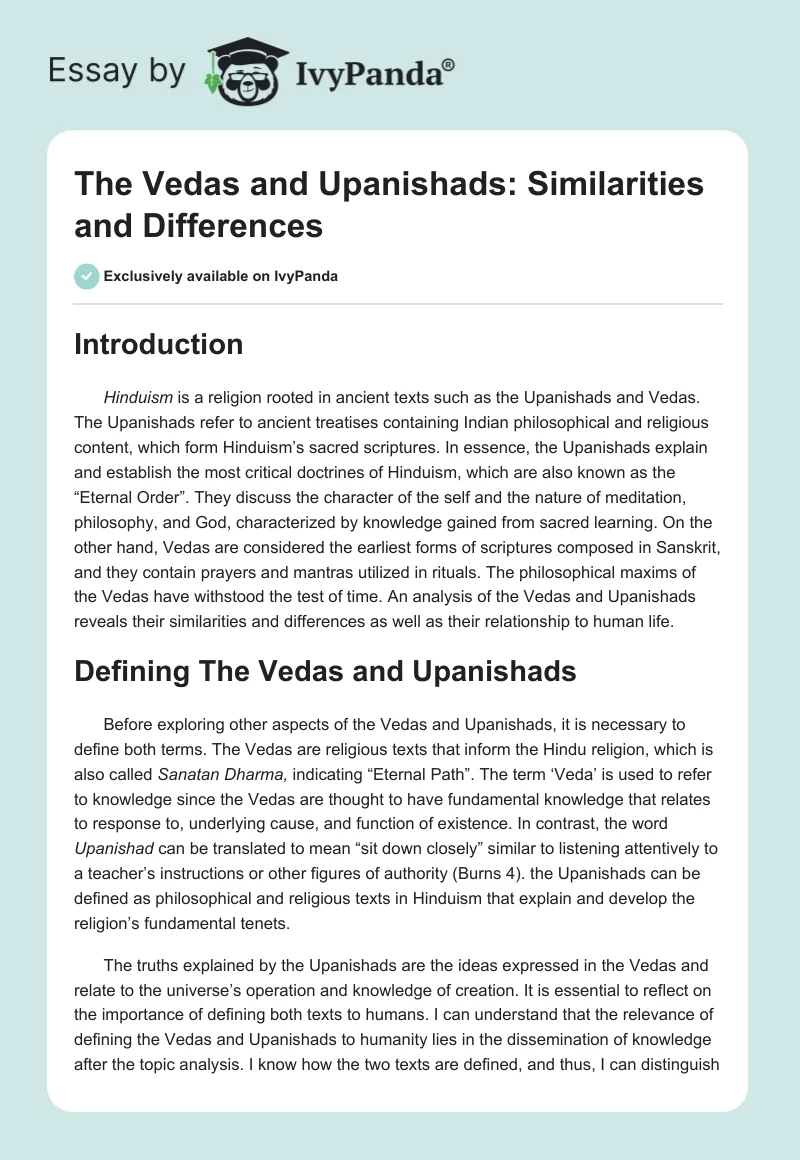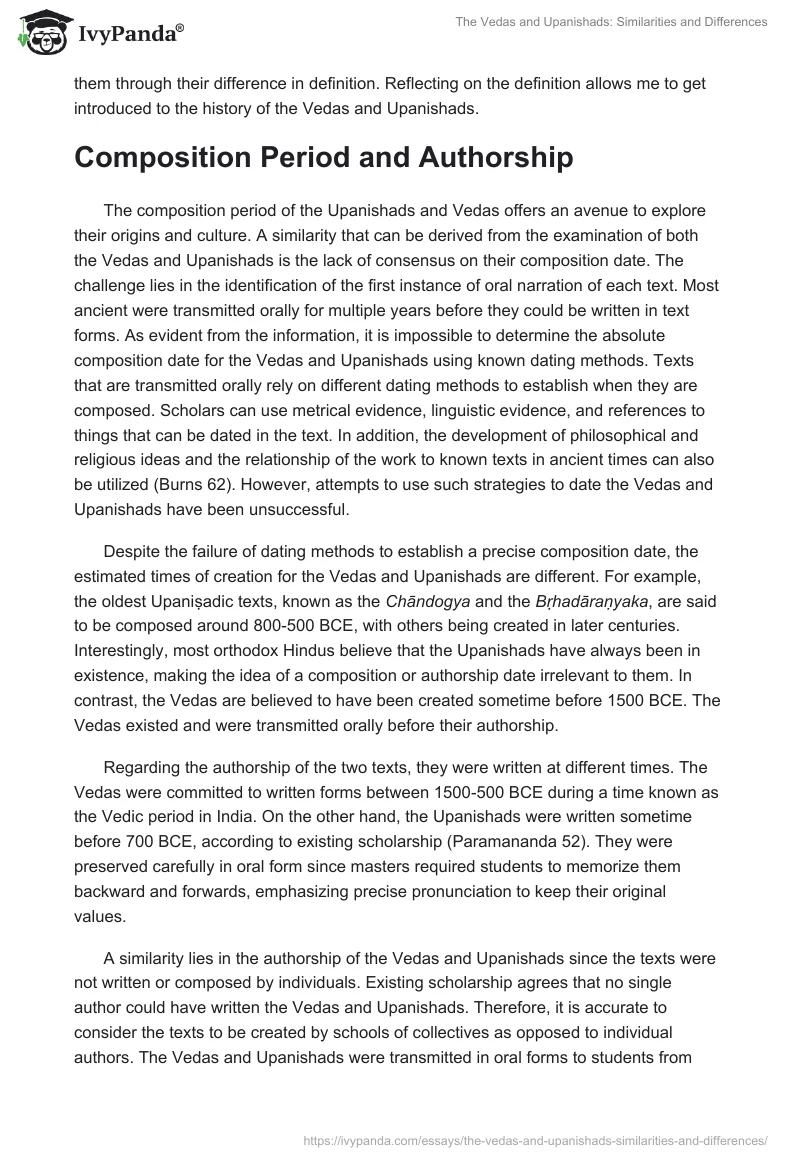Introduction
Hinduism is a religion rooted in ancient texts such as the Upanishads and Vedas. The Upanishads refer to ancient treatises containing Indian philosophical and religious content, which form Hinduism’s sacred scriptures. In essence, the Upanishads explain and establish the most critical doctrines of Hinduism, which are also known as the “Eternal Order”. They discuss the character of the self and the nature of meditation, philosophy, and God, characterized by knowledge gained from sacred learning. On the other hand, Vedas are considered the earliest forms of scriptures composed in Sanskrit, and they contain prayers and mantras utilized in rituals. The philosophical maxims of the Vedas have withstood the test of time. An analysis of the Vedas and Upanishads reveals their similarities and differences as well as their relationship to human life.
Defining The Vedas and Upanishads
Before exploring other aspects of the Vedas and Upanishads, it is necessary to define both terms. The Vedas are religious texts that inform the Hindu religion, which is also called Sanatan Dharma, indicating “Eternal Path”. The term ‘Veda’ is used to refer to knowledge since the Vedas are thought to have fundamental knowledge that relates to response to, underlying cause, and function of existence. In contrast, the word Upanishad can be translated to mean “sit down closely” similar to listening attentively to a teacher’s instructions or other figures of authority (Burns 4). the Upanishads can be defined as philosophical and religious texts in Hinduism that explain and develop the religion’s fundamental tenets.
The truths explained by the Upanishads are the ideas expressed in the Vedas and relate to the universe’s operation and knowledge of creation. It is essential to reflect on the importance of defining both texts to humans. I can understand that the relevance of defining the Vedas and Upanishads to humanity lies in the dissemination of knowledge after the topic analysis. I know how the two texts are defined, and thus, I can distinguish them through their difference in definition. Reflecting on the definition allows me to get introduced to the history of the Vedas and Upanishads.
Composition Period and Authorship
The composition period of the Upanishads and Vedas offers an avenue to explore their origins and culture. A similarity that can be derived from the examination of both the Vedas and Upanishads is the lack of consensus on their composition date. The challenge lies in the identification of the first instance of oral narration of each text. Most ancient were transmitted orally for multiple years before they could be written in text forms. As evident from the information, it is impossible to determine the absolute composition date for the Vedas and Upanishads using known dating methods. Texts that are transmitted orally rely on different dating methods to establish when they are composed. Scholars can use metrical evidence, linguistic evidence, and references to things that can be dated in the text. In addition, the development of philosophical and religious ideas and the relationship of the work to known texts in ancient times can also be utilized (Burns 62). However, attempts to use such strategies to date the Vedas and Upanishads have been unsuccessful.
Despite the failure of dating methods to establish a precise composition date, the estimated times of creation for the Vedas and Upanishads are different. For example, the oldest Upaniṣadic texts, known as the Chāndogya and the Bṛhadāraṇyaka, are said to be composed around 800-500 BCE, with others being created in later centuries. Interestingly, most orthodox Hindus believe that the Upanishads have always been in existence, making the idea of a composition or authorship date irrelevant to them. In contrast, the Vedas are believed to have been created sometime before 1500 BCE. The Vedas existed and were transmitted orally before their authorship.
Regarding the authorship of the two texts, they were written at different times. The Vedas were committed to written forms between 1500-500 BCE during a time known as the Vedic period in India. On the other hand, the Upanishads were written sometime before 700 BCE, according to existing scholarship (Paramananda 52). They were preserved carefully in oral form since masters required students to memorize them backward and forwards, emphasizing precise pronunciation to keep their original values.
A similarity lies in the authorship of the Vedas and Upanishads since the texts were not written or composed by individuals. Existing scholarship agrees that no single author could have written the Vedas and Upanishads. Therefore, it is accurate to consider the texts to be created by schools of collectives as opposed to individual authors. The Vedas and Upanishads were transmitted in oral forms to students from masters who were religious specialists. The group of religious specialists formed schools of transmission. Thus, the Upanishads and Vedas emerged as intellectual products of branches of intellectuals who specialized in a single ancient Vedic or Upanisadic text (Paramananda 98). As a result, the Vedas and Upanishads were authored by schools of intellectuals, not individuals.
Reflecting on the composition and authorship of the texts, a realization of the significance of their history emerges. The controversies and gaps in some questions regarding the authorship and composition of the Vedas and Upanishads make me curious about the subject. It is nervy to acknowledge that the origins of the Vedas and Upanishads will remain a mystery without a precise date of composition or authorship. Thus, the realization enables me to seek more information on the topic, improving my understanding and reinforcing my existing knowledge.
Types
There are different texts that make up the Upanishads and Vedas. Commonly considered Shruti, which means “what is heard”, the Vedas consist of several collections, including Rig Veda, Sama Veda, Atharva Veda, and Yajur Veda. Rig Veda is the oldest in Vegas, and its completion date is estimated to be near the end of the second millennium. The Rig Veda has hymns containing information on mythology, whereas the Sama Veda has hymns related to religious rituals. On the other hand, Yajur Veda consists primarily of religious rituals’ instructions, while the Atharva Veda contains spells that deter diseases, sorcerers, and enemies. In contrast, the Upanishads consist of thirteen texts which include Brhadaranyaka, Chandogya, Taittiriya, Aitareya, Kausitaki, Kena, Katha, Isha, Svetasvatara, Mundaka, Prashna, Maitri, and Mandukya (Paramananda 60). The types of the Upanishads and Vedas examine their structure and can help me to determine the main focus of each text.
Concepts
It is critical to consider the relationship between the Vedas and Upanishads before analyzing their concepts. The Upanishads are a part of the Vedas that is the most popular and read due to its presentation of discourse in a dialogue form. Thus, an analysis of the underlying concepts of the Vedas and Upanishads is affected by how the two texts are interwoven. The main concepts of the Vedas and Upanishads are similar due to the Upanishads being a part of the Vedas, and they include Brahman, Karma, Atman, and Samsara. Samsara refers to the repeating cycle of rebirths and deaths, whereas Atman makes references to one’s self or soul (Rao 35). Karma is the universal governing principle of every rebirth, while Brahman is the all-pervading and impersonal spirit.
Brahman’s failure to resonate with ordinary human beings made Vedic sages focus on the individual. As a result, the solution offered by sages was recognizing a higher self-known as the Atman that was part of Brahman that every person carried within. An individual’s soul and mind could not understand Brahman emotionally or intellectually; however, the Atman could achieve both since it was Brahman (Venkateshwar 160). Therefore, it meant that each person had a Divine spark within them, and their goal involved reuniting the spark with its source.
Realizing the existence of the Atman led to the conclusion that duality did not exist and life’s goal was self-actualization. Everyone had divine essence in themselves; therefore, there was no need to look for God since He was dwelling within their body and soul. A person had only to realize that God was within their souls, making them completely aware of their higher self. Thus, they could live according to the universe’s eternal order and, after dying, return home to be united with Brahman (Venkateshwar 152). Nonetheless, people had to perform their specific duty on earth through the right actions.
Conclusion
In conclusion, an examination of the Upanishads and Vedas show their differences and similarities and their relationship to human life. The Upanishads are a part of the Vedas and focus on the concept of the higher self that leads to self-actualization, which is the goal of life. An individual is expected to live by the right actions, which enables them to fulfill their duty on earth. Interacting with the texts has allowed me to understand them on a deeper level. The Upanishads and Vedas highlight the importance of their history and concepts to human life.
Works Cited
Burns, Graham. The Upanishads: Stories of the Self with Graham Burns: Neti, Neti; The Search for the Ultimate Principle in the Vedic Upanisads. Wise Studies, 2020.
Paramananda, Swami. The Upanishads. General Press, 2020.
Rao, Mukunda. Belief and Beyond: Adventures in Consciousness from the Upanishads to Modern Times. Harper Collins.
Venkateshwar, Parsa. The Upanishads: An Introduction. Harper Collins, 2020.


